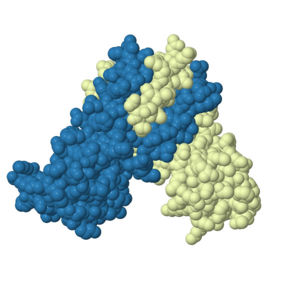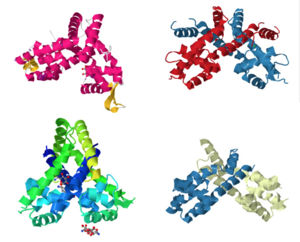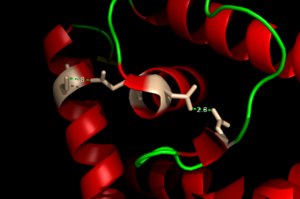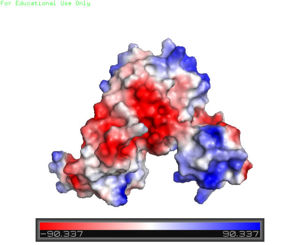Sandbox Reserved 1063
From Proteopedia
| Line 19: | Line 19: | ||
=== Hydrogen Bond Network === | === Hydrogen Bond Network === | ||
[[Image:H Bonding of DNA.png|300 px|left|thumb|The Hydrogen Bonding Network is shown with dotted green lines approximately 2.8 angstroms between residues. The network consists of 4 major residues as follows from right to left: E24, N38, Q40, S74. ]] | [[Image:H Bonding of DNA.png|300 px|left|thumb|The Hydrogen Bonding Network is shown with dotted green lines approximately 2.8 angstroms between residues. The network consists of 4 major residues as follows from right to left: E24, N38, Q40, S74. ]] | ||
| - | The binding of Zinc allows for the conformational change that induces the binding of DNA in order to activate genes. The binding of Zinc metals creates a hydrogen bond network within the protein that connects the metal binding sites and the [https://en.wikipedia.org/wiki/DNA-binding_domain DNA binding domain]. More importantly, the hydrogen bonding network connects the metal binding pockets to the alpha 4 helix. Alpha 4 helix on each monomer plays a crucial role in binding DNA because it acts as the <scene name='69/694230/Recognition_helix/1'> | + | The binding of Zinc allows for the conformational change that induces the binding of DNA in order to activate genes. The binding of Zinc metals creates a hydrogen bond network within the protein that connects the metal binding sites and the [https://en.wikipedia.org/wiki/DNA-binding_domain DNA binding domain]. More importantly, the hydrogen bonding network connects the metal binding pockets to the alpha 4 helix. Alpha 4 helix on each monomer plays a crucial role in binding DNA because it acts as the recognition helix. <scene name='69/694230/Recognition_helix/1'>Specific residues</scene> in the recognition helix recognize a sequence of DNA that is unknown at the moment; however, scientists do know that the hydrogen bond network acts as an allosteric activator for the protein to bind DNA. The hydrogen bond network connects the alpha 2 and alpha 4 helix via hydrogen bonding between specific residues. After zinc is bound, a glutamate (<font color='blue'>E24</font>) residue from a random coil accepts a hydrogen bond from the carboxamide end of an asparagine (<font color='green'>N38</font>) residue from the alpha 2 helix. Then, a glutamine (<font color='gold'>Q40</font>) residue from alpha 2 helix accepts a hydrogen bond from a serine (<font color='red'>S74</font>) residue from the alpha 4 helix. The color coding in the previous sentence represents the <scene name='69/694230/Hydrogen_bonding_1/1'>Hydrogen Bonding Network</scene> (<scene name='69/694230/Hydrogen_bonding_2/1'>Hydrogen Bonding Network with measurements</scene>), which is seen across the MarR family as a whole. |
[[Image:Charge_map.jpg |300 px|right|thumb| A charge map of AdcR shows the general triangular shape and the positive charged (blue) area on HTH domains]] | [[Image:Charge_map.jpg |300 px|right|thumb| A charge map of AdcR shows the general triangular shape and the positive charged (blue) area on HTH domains]] | ||
Revision as of 18:42, 31 March 2017
Adhesin Competence Regulator
Introduction
Adhesin Competence Regulator (AdcR) is a transcriptional regulator that controls the activation of over seventy genes within the bacteria Streptococcus pneumoniae[1]. Contrasting with other members of the multiple antibiotic resistance regulator (MarR) family, AdcR is metal dependent as the binding of Zinc causes conformational changes that permit AdcR to function as a transcriptional regulator. Zinc plays a vital role in organism homeostasis acting as a co-factor and a regulator of enzymatic activity, however zinc can lead to cell toxicity and deficiency of other vital metals that are also necessary for protein function[2][3]. Given the many roles zinc plays in general homeostasis the importance of AdcR in Streptococcus pneumoniae can be understood given its ability to regulate zinc transfer proteins within the bacteria.
Members of the MarR protein family conserve a number of features including a general triangular shape, a two fold pseudosymmetric homo dimer, and a wingled helix-turn-helix pattern. Consistent with AdcR's identity as a member of the MarR protein family, AdcR exhibits the triangular shape with the (wHTH) binding domain. This structure calls for multiple zinc binding sites that facilitate protein conformational change allowing for DNA binding and regulation through the wHTH domain.
| |||||||||||
References
- ↑ Sanson M, Makthal N, Flores AR, Olsen RJ, Musser JM, Kumaraswami M. Adhesin competence repressor (AdcR) from Streptococcus pyogenes controls adaptive responses to zinc limitation and contributes to virulence. Nucleic Acids Res. 2015 Jan;43(1):418-32. doi: 10.1093/nar/gku1304. Epub 2014 Dec, 15. PMID:25510500 doi:http://dx.doi.org/10.1093/nar/gku1304
- ↑ Fraústo da Silva J, Williams R. The Biological Chemistry of Elements: The Inorganic Chemistry of Life. Second ed. Oxford University Press; Oxford: 2001.
- ↑ Ma Z, Jacobsen FE, Giedroc DP. Coordination chemistry of bacterial metal transport and sensing. Chem Rev. 2009 Oct;109(10):4644-81. doi: 10.1021/cr900077w. PMID:19788177 doi:http://dx.doi.org/10.1021/cr900077w
- ↑ Guerra AJ, Dann CE, Giedroc DP. Crystal Structure of the Zinc-Dependent MarR Family Transcriptional Regulator AdcR in the Zn(II)-Bound State. J Am Chem Soc. 2011 Nov 21. PMID:22085181 doi:10.1021/ja2080532




